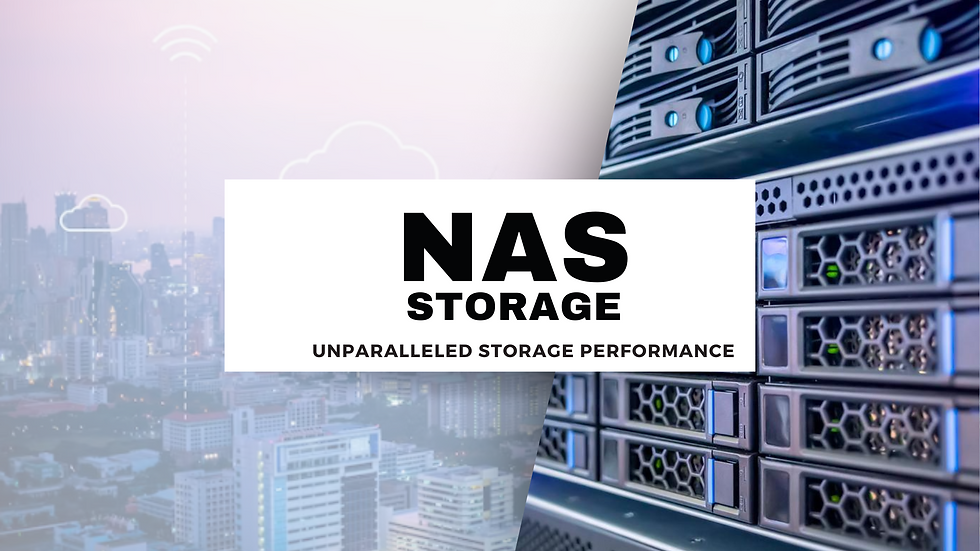Understanding NAS in Tech: A Comprehensive Guide
- Scale out nas
- Feb 1, 2024
- 3 min read

In the digital data-centric world we inhabit, the stream of data is continually growing. With this exponential growth, the need to store, manage, and share data in a reliable, efficient, and secure manner is more crucial than ever. Network-Attached Storage (NAS) stands as a cornerstone solution, providing organizations and individuals with an intelligent method for data management.
Introduction to NAS: A Pillar of Modern Data Management
At its core, NAS involves a storage device connected to a network, granting multiple users and various client devices, such as PCs or mobile devices, centralized access to diverse file types. By recognizing how NAS hardware and software work together, we can appreciate its importance across industries.
Today, enterprises rely on NAS for its role in simplifying and streamlining data management. At its simplest form, it’s likened to a multi-purpose toolbox. Need a hammer? It's there. Need pliers? They're there too. Only with NAS, you're storing, retrieving, and sharing data instead of fixing a sink.
What Exactly is NAS and Why is it Essential in Tech?
Let’s understand what is NAS? NAS is an intelligent data storage system that operates on a local area network (LAN). Its main purpose is to provide shared storage across a network. In doing so, it dedicates itself to three critical aspects of data management:
Storage Consolidation: With NAS, you can consolidate data into a single system. This means no more scattered drives or prolonged file searches.
Data Redundancy: NAS enhances data protection through redundancy. Redundancy ensures that even if one storage component fails, the system can utilize an alternate path, preventing data loss.
Easy Accessibility: As a network-attached system, NAS allows data to be accessed from multiple points—a necessity for any collaborative work environment.
The Benefits of NAS Storage
NAS offers a multitude of benefits that are revolutionizing the way data is managed, particularly in large organizations:
Improved Storage and Accessibility
Gone are the days of sorting through dozens of physical or virtual drives. NAS offers a streamlined way to organize and access data rapidly.
Scalability and Flexibility
In an age when data is growing faster than the storage to keep it, NAS is a flexible solution that scales alongside your enterprise. Capacity expansion is relatively simple, often a matter of plugging in additional drives.
Data Backup and Disaster Recovery
One of NAS's most critical features is its ability to store data safely, offering redundant storage and even enabling offsite backup for disaster recovery.
Types of NAS: Choosing the Right Solution for Your Needs
To understand NAS in its complexity, it’s vital to appreciate that different users have distinct requirements which prompt the existence of various NAS solutions:
Consumer NAS
Ideal for home use, a consumer NAS tends to be less complex and more user-friendly, offering features like media streaming and automatic backups for personal data.
Small Business NAS
Designed to handle the moderately growing data needs of small businesses, this NAS type often includes IT-friendly features like virtualization support and built-in security protocols.
Enterprise NAS
This NAS type is heavy-duty, tailored for high-scale data storage, large user counts, and extreme reliability, often including redundant components for no downtime.
Choosing the Right NAS Solution
Selecting the most appropriate NAS solution is paramount; it can mean the difference between operational smoothness and hiccups:
Factors to Consider
Considerations should include the size of your organization, the amount of data being managed, the required access speed, and budget constraints.
Key Features and Specifications
Understand the importance of factors such as storage capacity, RAID configurations for data protection, and the ability to serve multiple users concurrently without a performance downturn.
NAS in Action: Real-World Scenarios
The integration of NAS can present a host of workflows that illustrate its versatility and efficacy. For instance, in a creative agency, NAS could serve as the repository for extensive video editing files, accessible to all team members to facilitate collaboration. In contrast, in the healthcare sector, NAS could enable secure and compliant storage of patients' electronic health records.
Cloud vs. NAS: Finding a Balance
While the cloud has taken front and center as the leading data storage solution, NAS maintains its relevance by complementing and sometimes even outperforming cloud offerings, particularly when local and quick access is essential.
Security Concerns: Implementing NAS Safely
The dam of data needs to be protected from the rising tide of cyber threats. Implementing NAS solutions safely demands a focus on firewalls, anti-malware solutions, and strong access control measures to safeguard the stored data.
Vendor Spotlight: The Leading NAS Providers
Dive into the competitive landscape of NAS vendors to understand who’s leading the fray with innovative products and dependable service.
Conclusion
In an era where the integrity and accessibility of data define an organization's capabilities, NAS stands unyielding, a technological marvel that elevates data management to new heights. Whether you're a professional who relies on data for decision-making, an enthusiast who craves persistent storage for your digital life, or a business executive navigating the complex world of enterprise IT, understanding NAS is not just an asset; it’s an essential element in the modern tech lexicon.



Comments